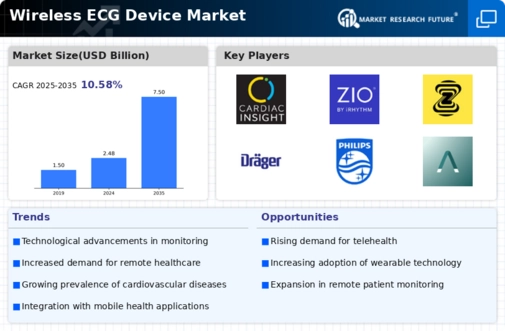Growing Aging Population
The Wireless ECG Device Market is significantly impacted by the growing aging population, which is more susceptible to cardiovascular diseases. As individuals age, the need for continuous health monitoring becomes increasingly critical. Wireless ECG devices provide a practical solution for elderly patients who may have mobility issues or prefer to manage their health from home. Recent demographic studies indicate that the population aged 65 and older is projected to double by 2050, leading to a heightened demand for remote monitoring solutions. This demographic shift is likely to drive the growth of the wireless ECG device market, as healthcare providers seek to accommodate the needs of an aging population.
Increased Focus on Preventive Healthcare
The Wireless ECG Device Market is benefiting from an increased focus on preventive healthcare measures. As healthcare systems shift towards proactive management of health conditions, the demand for devices that facilitate early detection of potential issues is rising. Wireless ECG devices empower individuals to monitor their heart health regularly, potentially leading to early diagnosis and reduced healthcare costs. The market is projected to expand as more consumers become health-conscious and seek out technologies that support preventive care. This trend aligns with broader healthcare initiatives aimed at reducing the burden of chronic diseases, further driving the adoption of wireless ECG devices.
Integration with Mobile Health Applications
The Wireless ECG Device Market is witnessing a surge in the integration of wireless ECG devices with mobile health applications. This integration allows users to easily track and manage their heart health through smartphones, enhancing user engagement and adherence to monitoring regimens. The convenience of accessing ECG data on mobile platforms is likely to attract a broader audience, including younger demographics who are more tech-savvy. As mobile health applications continue to gain traction, the demand for compatible wireless ECG devices is expected to rise, creating new opportunities for manufacturers in this evolving market.
Rising Incidence of Cardiovascular Diseases
The Wireless ECG Device Market is significantly influenced by the rising incidence of cardiovascular diseases worldwide. As heart-related ailments continue to escalate, there is a growing need for effective monitoring solutions. Wireless ECG devices offer a convenient way for patients to track their heart health, enabling timely interventions. Recent statistics indicate that cardiovascular diseases account for nearly 31% of all global deaths, underscoring the urgency for innovative monitoring technologies. This alarming trend is likely to propel the demand for wireless ECG devices, as healthcare providers seek efficient ways to manage and monitor patients with heart conditions.
Technological Advancements in Wireless ECG Devices
The Wireless ECG Device Market is experiencing rapid technological advancements that enhance device functionality and user experience. Innovations such as miniaturization of sensors and improved battery life are making these devices more accessible and user-friendly. The integration of artificial intelligence and machine learning algorithms into ECG devices allows for real-time data analysis, potentially leading to quicker diagnosis and treatment. According to recent data, the market for wireless ECG devices is projected to grow at a compound annual growth rate of approximately 25% over the next five years. This growth is driven by the increasing demand for remote patient monitoring solutions, which are becoming essential in modern healthcare.
























Leave a Comment